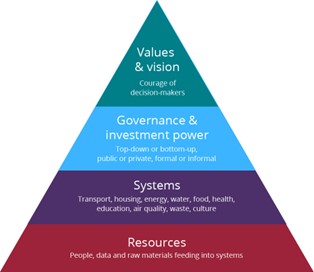With urban populations only going to increase, how can we ensure they minimise their environmental impact and can withstand the challenges of a changing climate?
This article was originally published in Italian in Consiglio Nazionale degli Ingegneri (access it here) and has been reproduced in English with their permission.
Cities have always played a crucial role in human development, particularly economic growth and innovation: it is estimated that they generate more than 80% of global GDP.
In recent decades, urbanisation has increased worldwide, and today urban centers face the same challenges: climate change, population growth, ageing infrastructure, and resource depletion. According to the UN, cities consume 78% of global energy and produce 60% of greenhouse gas emissions, despite covering only about 2% of the Earth's surface.
The development of resilient urban systems is therefore a priority to ensure a prosperous future for future generations. With this in mind, all public and private actors are called on to collaborate in transforming current structures and adapting them to achieve common objectives, from the UN Sustainable Development Goals (SDGs) to net-zero carbon by 2050.
Governments play a fundamental role in defining sustainable development. Bold policies and regulations that have a long-term vision – such as the European Green Deal – can foster innovation and investment in cities, including funding for researching and developing new technologies. However, it is municipalities, companies, infrastructure providers, educational institutions and social actors who together shape the evolution of sustainable projects that enact the circular economy.
Urban development must be managed at several levels
According to UN-Habitat 68% of the world’s population will reside in cities by 2050, an increase of 2.5bn compared to today. To manage urban development, action is needed at the following three levels.
Regional
Localising international and national directives requires in-depth knowledge of the territory, particularly its social and economic development.
Reducing energy consumption and land use are priorities for regional administrations. In terms of energy, close collaboration between government and industry promotes sustainable investments, reducing dependence on fossil fuels and other non-renewable sources while distributing resources according to regional needs.
Attention to housing needs meanwhile involves both the modernisation of existing housing stock with energy-saving measures and the construction of new homes with shared and sustainable community services.
Cities
Every city must develop an integrated plan for sustainable transition, identifying areas of concern and adapting infrastructure to form a network of sustainable measures.
Dedicated actions include the development of green spaces and cycling paths, the transformation of mobility towards sustainability, and the creation of spaces for community development and cohesion.
The C40, a global network of sustainable cities, offers numerous case studies on this approach, including projects related to mobility, waste and food management, prevention and mitigation of extreme natural events, and equitable and sustainable housing development.
Neighbourhoods
Within cities, neighborhoods can address various concerns in a tangible way for individual citizens.
The Schouwburg Square in Rotterdam is a symbol of the integrated approach between property owners, institutions, businesses and municipalities. New technologies and circular economic measures will enable this square to become climate-neutral by 2030. This can be realized by collecting rainwater for reuse from the rooftops, and offering more green space and gathering places for people to experience the city on multiple levels. On the energy front, a decentralised and collective sustainable heating and cooling grid will be developed.
In Milan, the Piazzale Loreto transformation project will reshape traffic areas by encouraging soft mobility (non-motorised forms of mobility), lowering the temperature by up to 2°C through sustainable design choices and the presence of more than 200 trees. There will be new space for the community, integrating existing services and improving connections with other areas of the city.
How networks help develop sustainable cities
The urban network can be represented conceptually by a pyramid, as shown in Figure 1, in which each level interacts constantly.
At the top, the historical, geographical, and socioeconomic dimensions converge in the value structure that distinguishes the city, and can be enhanced through a bold vision from legislators. Investing in the outstanding characteristics of a place, in a sustainable way, means involving all the underlying levels.
First, local governance must enable access for all actors, both public and private, through dedicated pathways. An example is the public–private partnership, which promotes the interpenetration of knowledge and available resources for each party. These are living laboratories that require initial funding, to which other investments are linked, helping accelerate the adoption of innovations and new approaches. Citizens and local associations should be engaged in this process, as they will support and contribute to the lasting growth of these projects through proposals, criticism and suggestions for improvement.
Next, systems are the level through which spaces come to life. Their transformation and decarbonisation reflect social and environmental changes, providing smart and reliable services for citizens.
Finally, at the base of the pyramid there are the resources that become part of the city – people, data and raw materials. A careful analysis of these allows for the continuous reworking of all upper levels, refining the model of each city.
Developments show how ESG ambitions are realised
This model can be realised when projects are capable of going beyond technical aspects, and consider environmental, social and governance (ESG) objectives from the outset.
The Johan Cruyff Arena in Amsterdam for instance has been transformed. This entertainment venue now also incorporates an energy system serving the stadium and community. The structure now incorporates 4,200 solar panels and a 3MW storage system, including second-generation batteries. Limited use during the week reduces consumption during peak hours and supports the local energy grid.
Another example is the multifunctional RAI convention centre, also in Amsterdam, which has combined its existing infrastructure with a sustainable mobility hub, implementing water recycling, photovoltaic systems, biodiversity protection and area cooling.





